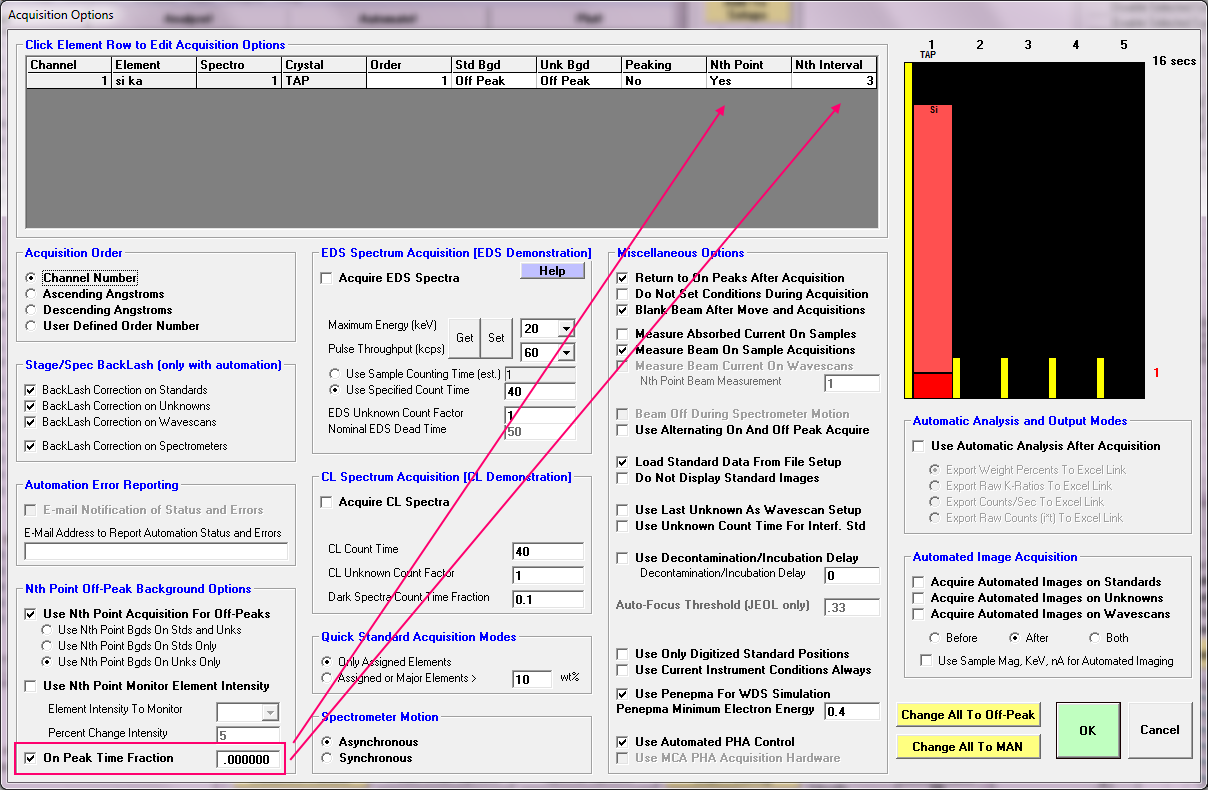I couldn't find a topic devoted to Nth point background acquisition, though I'm sure it must be somewhere...
Anyway, Julien Allaz and I were having a bit of a chin wag last week regarding the "on-peak time fraction" option that is utilized for the Nth point background feature. For those that aren't aware this is a cool option for those that need to measure off-peak backgrounds, but do not need to measure the backgrounds on every point.
This might be because the sample is very homogeneous and so the background isn't changing much, or it might be that one is measuring traces in beam sensitive samples (e.g., monazite) and by the time the background is being measured the sample is damaged enough to affect the background intensity measurement.
Now one could instead utilize the "alternating off/off peak" feature, which by setting the Unknown Count factor to more than 1.0, and checking the Use Alternating On and Off peak Acquire option in the Acquire! Acquisition Options dialog, the program will alternately acquire sub intervals on the peak and off the peak in order to better track the "delta" of the net intensities over time. See here for more details:
https://probesoftware.com/smf/index.php?topic=812.0But the On Peak Time Fraction option, seen also in the Acquisition Options dialog, now allows for a value of zero for the On Peak Time Fraction as seen here:

This means that for the Nth point measurement, one can now acquire *no* on-peak intensity data and instead acquire only the off-peak intensity data. Furthermore, the program will not even move to the on-peak position and in fact will even "mark" this acquisition as "B" (for bad) so it will automatically not be included in the analysis as seen here:
On-Peak (off-peak corrected) or EDS (bgd corrected) or MAN On-Peak X-ray Counts (cps/1nA) (and Faraday/Absorbed Currents):
ELEM: si ka BEAM1 BEAM2
BGD: OFF
SPEC: 1
CRYST: TAP
ORDER: 1
21B -.31 30.025 30.017
22G 230.66 29.982 30.001
23G 231.54 29.978 29.987
24B -.37 29.995 29.994
25G 231.13 29.992 30.013
26G 231.41 30.005 30.013
27B -.39 29.981 29.999
28G 232.31 30.009 29.993
29G 231.30 30.010 29.977
30B -.42 29.986 30.002
AVER: 231.39 29.996 29.997
SDEV: .55 .014 .015
1SIG: .88
SIGR: .62
SERR: .22
%RSD: .24
Off-Peak (calculated) or EDS (bgd) X-ray Counts (cps/1nA):
ELEM: si ka
TYPE: LINEAR
NthPT: 3
21B .31
22G .31
23G .31
24B .37
25G .37
26G .37
27B .39
28G .39
29G .39
30B .42
Raw Hi-Peak X-ray Counts (cps/1nA):
ELEM: si ka
21B .28
22G .28
23G .28
24B .30
25G .30
26G .30
27B .32
28G .32
29G .32
30B .41
Raw Lo-Peak X-ray Counts (cps/1nA):
ELEM: si ka
21B .35
22G .35
23G .35
24B .44
25G .44
26G .44
27B .46
28G .46
29G .46
30B .43
In the above acquisition the Nth point was set to 3, and the on-peak time fraction was set to zero. Note how the same off-peak backgrounds are utilized every N points every Nth point.
So when the sample is analyzed, the "B" points are automatically skipped:
Un 3 Fe, V, C 1A, 7, Results in Elemental Weight Percents
ELEM: Si
TYPE: ANAL
BGDS: LIN
TIME: 10.00
BEAM: 30.00
ELEM: Si SUM
22 98.922 98.922
23 99.301 99.301
25 99.122 99.122
26 99.246 99.246
28 99.632 99.632
29 99.196 99.196
AVER: 99.237 99.237
SDEV: .234 .234
SERR: .096
%RSD: .24
STDS: 14
STKF: .4101
STCT: 95.62
UNKF: .9924
UNCT: 231.39
UNBG: .36
ZCOR: 1.0000
KRAW: 2.4199
PKBG: 655.15
Please let me know what you all think of this new feature.